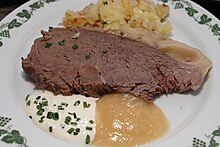Viennese cuisine
This article needs additional citations for verification. (January 2021) |
Viennese cuisine is the
Viennese cuisine is best known for its
Vienna has been the capital of Austria for more than a thousand years. It became the cultural centre of the nation and developed its own regional cuisine; as such, Viennese cuisine has distinct cooking.[5]
The variety of ingredients sold on the
History
The Viennese cooking tradition developed from many different sources: "Viennese cuisine is all about—an eclectic mix of cuisines from Europe and beyond, of all regions and lands that were once part of the monarchy."[6]
Italian influence has been strong since roughly the early 17th Century. In the 18th Century, French cuisine became influential in Vienna, along with French etiquette and diplomatic language. The term "Wiener Küche" (Viennese cuisine) first appeared in German language cookbooks around the end of the 18th century, and it was mistakenly treated as equivalent to Austrian cuisine.
The croissant is also thought to have originated in Vienna after the defeat of the Turks in the Siege of Vienna.
In the second half of the 19th century, cookbooks started to include Bohemian, Hungarian, Italian, Jewish,
Modern Viennese cuisine
In modern Vienna, many chefs have begun to combine traditional Viennese dishes with the principles of
Also,
Coffee houses
The
Viennese dishes

Typical Viennese dishes include:
- Apfelstrudel (an apple-filled pastry)
- Topfenstrudel (a quark cheese-filled strudel)
- Palatschinken (Viennese crêpes)
- Kaiserschmarrn (caramelized and shredded pancake)
- Buchteln (from Czech buchty): sweet rolls made of yeast dough, filled, traditionally, with Powidl, (or, in some modern variants, with apricot jam) and butter-baked.
- Germknödel
- Marillenknödel
- Powidl (from Czech povidla)
- Sachertorte (a chocolate cake)
- Wiener schnitzel
- Backhendl
- Tafelspitz (boiled beef, often served with apple and horseradish sauces)
- Gulasch (a hotpot similar to Hungarian pörkölt, gulyás is stew with more sauce or soup in Hungary)
- Selchfleisch (smoked meat) with Sauerkraut and dumplings.
- Rindsuppe (beef soup)
- Beuschel (a ragout containing veal lungs and heart)
- Liptauer cheese
See also
- Vienna bread, the unique and influential style of lighter bread with fresh leavening that developed in Vienna
- Viennoiserie, a French term referring to baked goods in the style of or influenced by Viennese baking
References
- ^ Muckerman, Anna (6 August 2019). "Does this schnitzel define Vienna?". BBC. Retrieved 17 January 2021.
- ^ Bacon, Susanne (9 August 2019). "Across the Fence: Schnitzel". Subrurban Times. Retrieved 17 January 2021.
- ^ King, Chula (3 October 2018). "Schnitzel and potatoes make for grand Oktoberfest celebration". Tallahassee Democrat. Retrieved 17 January 2021.
- ^ a b Müller, Holly (10 February 2016). "Coffee in the anti-cafe: hipsters beware Vienna's Cafe Am Heumarkt". The Guardian. Retrieved 17 January 2021.
- ^ Archived column on Vienna
- ^ AFAR. Retrieved 17 January 2021.
- ^ University of Illinois. Retrieved 17 January 2021.
- ^ Breuer, Rayna (11 November 2020). "How the Nazis Stole a Cookbook Alice Urbach's cookbook was a bestseller in the 1930s in German-speaking countries. A Jew, she fled her home under the Nazis, who republished the book under a different name without giving her credit". The Wire. Retrieved 17 January 2021.
- ^ a b Rushby, Kevin (16 December 2019). "A local's guide: Vienna holidays: A local's guide to Vienna: 10 top tips: With such a rich cultural and historical heritage, the Austrian capital is a wonder to wander but don't overlook its diverse neighbourhoods, cuisine and bars". The Guardian. Retrieved 17 January 2021.
- New York Times. Retrieved January 17, 2021.
- ^ Intangible Cultural Heritage in Austria: Viennese Coffee House Culture
